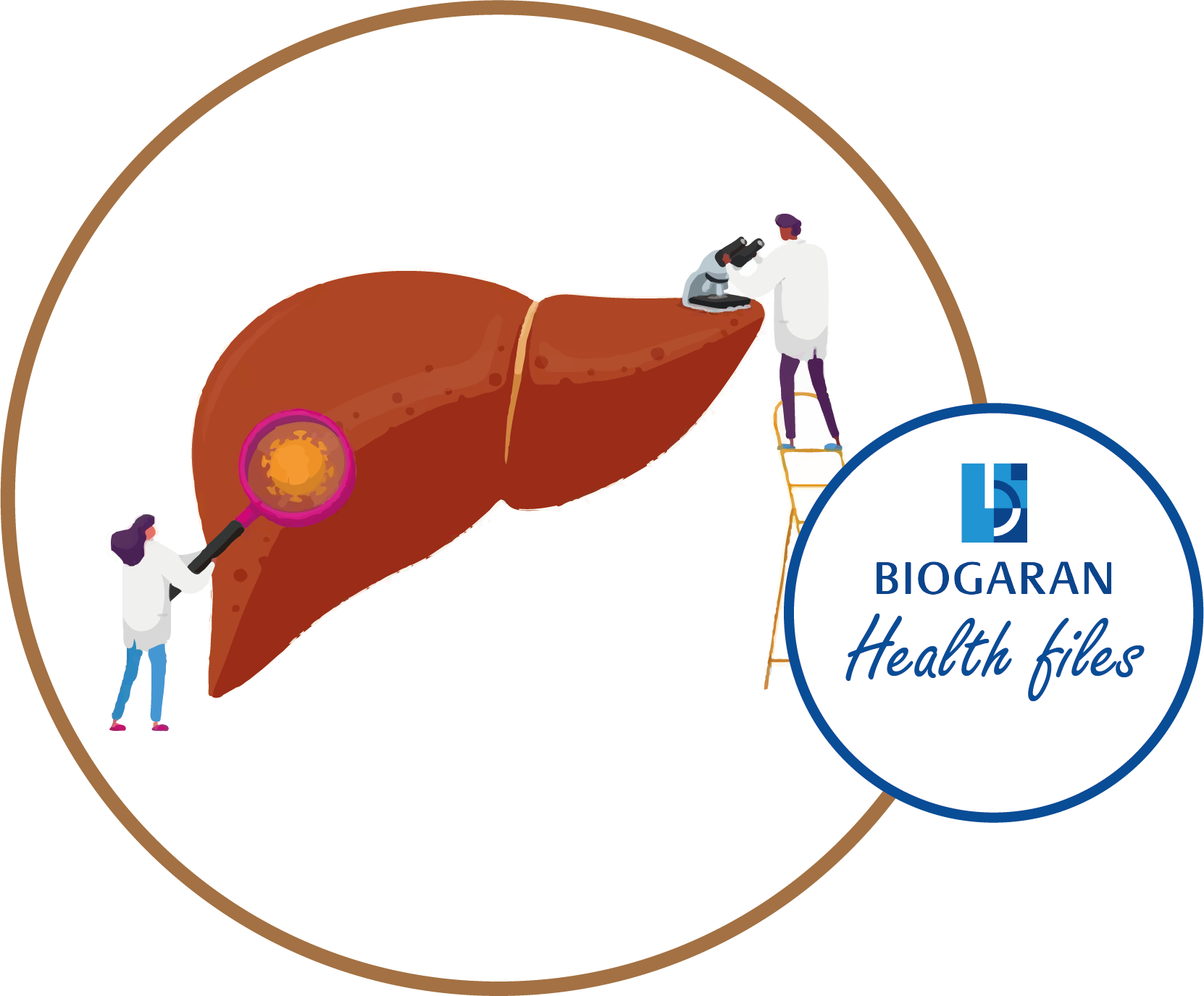Hepatitis
Go through our health file to learn more about hepatitis.

Posted on
I) What is hepatitis ?
Hepatitis refers to any inflammation of the liver that can be caused by toxic substances or in most cases by viruses [1].
These viruses, differentiated by 5 letters (A, B, C, D and E) cause a local infection and inflammation of the liver [1]. They are differentiated by their methods of transmission and their aggressiveness [1].
Hepatitis can be acute or chronic.
- Acute hepatitis is defined as a sudden onset that lasts only a few weeks [2].
- It is chronic when it lasts for more than 6 months [3].
II) What are the characteristics of the different hepatitis ?

III) Diagnosis and screening of at-risk populations
In the various cases of hepatitis, early diagnosis could promote rapid recovery and avoid chronic forms. Thus, it is important for people at risk of infection to be screened.
At-risk populations include:
- Unvaccinated and previously uninfected individuals [7].
- Pregnant women [6].
- Children born to mothers with hepatitis [9].
- People who stay in or travel to countries where hepatitis is common [7].
- Relatives of infected persons [7].
- People who live in areas with poor hygiene, sewage disposal or disinfection practices [12].
- People who work in laboratories or hospitals and who handle blood and may encounter viruses [6].
- People who inject drugs [9].
- People in prisons or other closed settings [9].
- People with HIV infection [9].
- People with tattoos or piercings [9].
- People who have unprotected sex with multiple partners [8].
IV) What are the right things to do to avoid hepatitis ?
1. Vaccination
While vaccines against hepatitis C and D do not exist, it is possible to vaccinate against the other hepatitises (A, B, E). Since hepatitis D can only develop if the person has been infected with hepatitis B, the hepatitis B vaccine also protects against hepatitis D [10]. Vaccination is recommended for all populations at risk.
It is especially important for children, as they are more fragile and highly subject to this type of disease. The WHO recommends that hepatitis B be controlled during or after birth of children through vaccination at birth and screening of pregnant women [4]. It is also important to be vaccinated before traveling to endemic areas or areas with low levels of hygiene [7].
2. Follow strict hygiene rules
Hepatitis A and hepatitis E are forms of hepatitis related to the level of hygiene. It is important to consume clean water and food that has been disinfected [7]. It is also important to be vigilant about eating raw food and to cook food to eliminate bacteria and viruses. Prevention involves hygiene rules such as washing your hands regularly with soap and water after using the toilet, before cooking or feeding your children [7]. It is necessary to remember to disinfect toilets and bathrooms regularly.
3. Avoid high-risk behaviors
In the case of hepatitis B, C and D, contamination is generally through blood, biological secretions and sexual contact [1]. Thus, it is important to avoid risky sexual relations, i.e., unprotected sex with multiple partners. It is also important to avoid sharing or exchanging certain materials or products such as toothbrushes, piercing equipment, razors, needles and syringes [12]. It is also crucial to reduce the risk of exposure to the virus in healthcare facilities by using safe injections, disinfecting medical equipment, screening blood donations, training healthcare professionals and avoiding handling sharp objects [11].
4. Control your alcohol consumption and diet
Hepatitis is often caused by infection but can also be of toxic origin [1]. Excessive alcohol consumption is a danger to the liver and can often lead to cirrhosis [3]. This is because when alcohol is consumed, it is metabolized in the liver and can produce substances that can damage the liver [3]. Thus, people with any form of hepatitis are strongly advised against drinking alcohol, as scar tissue can form in the liver and replace normal liver tissue [3]. Eating habits should also be monitored. People who are overweight, diabetic or have high levels of cholesterol or other fats are at high risk for some types of chronic hepatitis [3].
SOURCES:
[1] Viral Hepatitis – Institut pasteur – Available at: https://www.pasteur.fr/fr/centre-medical/fiches-maladies/hepatites-virales#:~:text=A%20h%C3%A1patitis%20is%20an%20inflammation,virus%20(majority%C3%A1%20of%20cases).
[2] Presentation of acute viral hepatitis – The MSD Manual – Available at: https://www.msdmanuals.com/fr/accueil/troubles-du-foie-et-de-la-v%C3%A1sicule-biliaire/h%C3%A1patite/pr%C3%A1sentation-de-l-h%C3%A1patite-virale-aigu%C3%AB
[3] Presentation of chronic hepatitis – The MSD manual – Available at: https://www.msdmanuals.com/fr/accueil/troubles-du-foie-et-de-la-v%C3%A1sicule-biliaire/h%C3%A1patite/pr%C3%A1sentation-de-l-h%C3%A1patite-chronique
[4] World Hepatitis Day on July 28, 2021 – WHO – Available at: https://www.afro.who.int/fr/regional-director/speeches-messages/journee-mondiale-contre-lhepatite-le-28-juillet-2021
[5] VIRAL HEPATITIS: IN AFRICA, ONLY 1% OF PATIENTS HAVE ACCESS TO ANTIVIRALS – SFMU – Available at: https://www.sfmu.org/fr/actualites/actualites-de-l-urgences/hepatites-virales-en-afrique-seuls-1-des-malades-ont-acces-aux-antiviraux/new_id/67185#:~:text=PARIS%2C%208%20March%2021%20(APMnews,press%20opening%20of%20la
[6] Hepatitis A – The MSD Manual – Available at: https://www.msdmanuals.com/fr/accueil/troubles-du-foie-et-de-la-v%C3%A9sicule-biliaire/h%C3%A9patite/h%C3%A9patite-a-aigu%C3%AB
[7] Hepatitis – Ministry of Health and Prevention – Available at: Hepatitis A – Ministry of Solidarity and Health (solidarites-sante.gouv.fr)
[8] Acute hepatitis B – The MSD manual – Available at: https://www.msdmanuals.com/fr/accueil/troubles-du-foie-et-de-la-v%C3%A9sicule-biliaire/h%C3%A9patite/h%C3%A9patite-b-aigu%C3%AB
[9] Hepatitis C – WHO – Available at: https://www.who.int/fr/news-room/fact-sheets/detail/hepatitis-c#:~:text=H%C3%A1patitis%20C%20is%20one,and%20the%20cancer%20of%20the%20foie.
[10] Hepatitis D – WHO – Available at: https://www.who.int/fr/news-room/fact-sheets/detail/hepatitis-d
[11] Hepatitis E – WHO – Available at https://www.who.int/fr/news-room/fact-sheets/detail/hepatitis-e
[12] A, B, C, D, E, WHAT IS HEPATITIS? – AIDES – Available at: https://www.aides.org/dossier/b-c-d-e-une-hepatite-cest-quoi
[13] Hepatitis B – World Health Organization – https://www.who.int/fr/news-room/fact-sheets/detail/hepatitis-b
POI 0713-09/22
